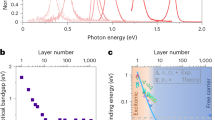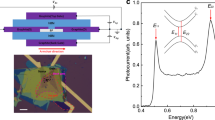Abstract
Phosphorene, a single atomic layer of black phosphorus, has recently emerged as a new two-dimensional (2D) material that holds promise for electronic and photonic technologies1,2,3,4,5. Here we experimentally demonstrate that the electronic structure of few-layer phosphorene varies significantly with the number of layers, in good agreement with theoretical predictions. The interband optical transitions cover a wide, technologically important spectral range from the visible to the mid-infrared. In addition, we observe strong photoluminescence in few-layer phosphorene at energies that closely match the absorption edge, indicating that they are direct bandgap semiconductors. The strongly layer-dependent electronic structure of phosphorene, in combination with its high electrical mobility, gives it distinct advantages over other 2D materials in electronic and opto-electronic applications.
This is a preview of subscription content, access via your institution
Access options
Subscribe to this journal
Receive 12 print issues and online access
$259.00 per year
only $21.58 per issue
Buy this article
- Purchase on Springer Link
- Instant access to full article PDF
Prices may be subject to local taxes which are calculated during checkout




Similar content being viewed by others
References
Li, L. et al. Black phosphorus field-effect transistors. Nat. Nanotech. 9, 372–377 (2014).
Liu, H. et al. Phosphorene: an unexplored 2D semiconductor with a high hole mobility. ACS Nano 8, 4033–4041 (2014).
Xia, F., Wang, H. & Jia, Y. Rediscovering black phosphorus as an anisotropic layered material for optoelectronics and electronics. Nat. Commun. 5, 4458 (2014).
Koenig, S. P., Doganov, R. A., Schmidt, H., Neto, A. H. C. & Özyilmaz, B. Electric field effect in ultrathin black phosphorus. Appl. Phys. Lett. 104, 103106 (2014).
Castellanos-Gomez, A. et al. Isolation and characterization of few-layer black phosphorus. 2D Mater. 1, 025001 (2014).
Watanabe, K., Taniguchi, T. & Kanda, H. Direct-bandgap properties and evidence for ultraviolet lasing of hexagonal boron nitride single crystal. Nat. Mater. 3, 404–409 (2004).
Novoselov, K. S. et al. Two-dimensional gas of massless Dirac fermions in graphene. Nature 438, 197–200 (2005).
Zhang, Y., Tan, Y.-W., Stormer, H. L. & Kim, P. Experimental observation of the quantum Hall effect and Berry's phase in graphene. Nature 438, 201–204 (2005).
Mak, K. F., Lee, C., Hone, J., Shan, J. & Heinz, T. F. Atomically thin MoS2: a new direct-gap semiconductor. Phys. Rev. Lett. 105, 136805 (2010).
Hunt, B. et al. Massive Dirac fermions and Hofstadter butterfly in a van der Waals heterostructure. Science 340, 1427–1430 (2013).
Xu, X., Yao, W., Xiao, D. & Heinz, T. F. Spin and pseudospins in layered transition metal dichalcogenides. Nat. Phys. 10, 343–350 (2014).
Xi, X. et al. Strongly enhanced charge-density-wave order in monolayer NbSe2 . Nat. Nanotech. 10, 765–769 (2015).
Dean, C. R. et al. Hofstadter's butterfly and the fractal quantum Hall effect in moire superlattices. Nature 497, 598–602 (2013).
Churchill, H. O. H. & Jarillo-Herrero, P. Two-dimensional crystals: phosphorus joins the family. Nat. Nanotech. 9, 330–331 (2014).
Sze, S. M. & Ng, K. K. Physics of Semiconductor Devices (John Wiley & Sons, 2006).
Takao, Y. & Morita, A. Electronic structure of black phosphorus: tight binding approach. Phys. B+C 105, 93–98 (1981).
Asahina, H., Shindo, K. & Morita, A. Electronic structure of black phosphorus in self-consistent pseudopotential approach. J. Phys. Soc. Jpn. 51, 1193–1199 (1982).
Qiao, J., Kong, X., Hu, Z.-X., Yang, F. & Ji, W. High-mobility transport anisotropy and linear dichroism in few-layer black phosphorus. Nat. Commun. 5, 4475 (2014).
Tran, V., Soklaski, R., Liang, Y. & Yang, L. Layer-controlled band gap and anisotropic excitons in few-layer black phosphorus. Phys. Rev. B 89, 235319 (2014).
Low, T. et al. Tunable optical properties of multilayer black phosphorus thin films. Phys. Rev. B 90, 075434 (2014).
Hultgren, R., Gingrich, N. S. & Warren, B. E. The atomic distribution in red and black phosphorus and the crystal structure of black phosphorus. J. Chem. Phys. 3, 351–355 (1935).
Zhang, S. et al. Extraordinary photoluminescence and strong temperature/angle-dependent Raman responses in few-layer phosphorene. ACS Nano 8, 9590–9596 (2014).
Zhang, S. et al. Extraordinarily bound quasi-one-dimensional trions in two-dimensional phosphorene atomic semiconductors. Preprint at http://arxiv.org/abs/1411.6124 (2014).
Yang, J. et al. Optical tuning of exciton and trion emissions in monolayer phosphorene. Light Sci. Appl. 4, e312 (2015).
Wang, X. et al. Highly anisotropic and robust excitons in monolayer black phosphorus. Nat. Nanotech. 10, 517–521 (2015).
Kim, J. et al. Observation of tunable band gap and anisotropic Dirac semimetal state in black phosphorus. Science 349, 723–726 (2015).
Rodin, A. S., Carvalho, A. & Castro Neto, A. H. Strain-induced gap modification in black phosphorus. Phys. Rev. Lett. 112, 176801 (2014).
Wang, L. et al. One-dimensional electrical contact to a two-dimensional material. Science 342, 614–617 (2013).
YU, P. & Cardona, M. Fundamentals of Semiconductors: Physics and Materials Properties (Springer, 2010).
Yang, F., Wilkinson, M., Austin, E. J. & O'Donnell, K. P. Origin of the stokes shift: a geometrical model of exciton spectra in 2D semiconductors. Phys. Rev. Lett. 70, 323–326 (1993).
Polimeni, A. et al. Stokes shift in quantum wells: trapping versus thermalization. Phys. Rev. B 54, 16389–16392 (1996).
Acknowledgements
L.L., Z.Z., F.Y. and Y.Z. acknowledge support from the NSF of China (grant nos 11425415 and 11421404) and the National Basic Research Program of China (973 Program; grant no. 2013CB921902). J.K., C.J. and F.W. acknowledge support from National Science Foundation EFRI program (EFMA-1542741). L.L. and Y.Z. also acknowledge support from Samsung Global Research Outreach (GRO) Program. Part of the sample fabrication was conducted at Fudan Nano-fabrication Lab. G.Y and X.C. acknowledge support from the NSF of China (grant no. 11534010), the ‘Strategic Priority Research Program’ of the Chinese Academy of Sciences (grant no. XDB04040100) and the National Basic Research Program of China (973 Program; grant no. 2012CB922002). K.W. and T.T. acknowledge support from the Elemental Strategy Initiative conducted by the MEXT, Japan. T.T. also acknowledges support by a Grant-in-Aid for Scientific Research on Innovative Areas, ‘Nano Informatics’ (grant nos 262480621 and 25106006) from JSPS. D.Y.Q., F.H.d.J. and S.G.L. thank T. Cao and Z. Li for discussions. The theoretical studies were supported by the Theory of Materials Program at the Lawrence Berkeley National Laboratory through the Office of Basic Energy Sciences, US Department of Energy under Contract no. DE-AC02-05CH11231, which provided for the ab initio GW-BSE calculations, and by the National Science Foundation under Grant no. DMR-1508412, which provided for the DFT calculations and theoretical analyses of the interlayer interactions and substrate screening. D.Y.Q. acknowledges support from the NSF Graduate Research Fellowship Grant no. DGE 1106400. This research used resources of the National Energy Research Scientific Computing Center, which is supported by the Office of Science of the US Department of Energy, and the Extreme Science and Engineering Discovery Environment (XSEDE), which is supported by National Science Foundation grant no. ACI-1053575.
Author information
Authors and Affiliations
Contributions
F.W., Y.Z. and X.H.C. conceived the project. G.J.Y., X.H.C., L.C. and W.R. grew the bulk crystal black phosphorus. L.L. fabricated and characterized the encapsulated samples. J.K. and C.J. designed and built the absorption and PL set-up. L.L., J.K. and C.J. obtained and analysed the absorption and PL spectra. C.J. performed the tight-binding phenomenological model. D.Y.Q., F.H.d.J. and S.G.L performed the ab initio DFT and GW-BSE calculations. Z.S. helped with FTIR measurements and Z.Z. and F.Y. helped with sample fabrication. K.W. and T.T. grew the hBN crystal. All authors discussed and wrote the manuscript.
Corresponding authors
Ethics declarations
Competing interests
The authors declare no competing financial interests.
Supplementary information
Supplementary information
Supplementary information (PDF 676 kb)
Rights and permissions
About this article
Cite this article
Li, L., Kim, J., Jin, C. et al. Direct observation of the layer-dependent electronic structure in phosphorene. Nature Nanotech 12, 21–25 (2017). https://doi.org/10.1038/nnano.2016.171
Received:
Accepted:
Published:
Issue Date:
DOI: https://doi.org/10.1038/nnano.2016.171
This article is cited by
-
Engineering interlayer hybridization in van der Waals bilayers
Nature Reviews Materials (2024)
-
Near-field detection of gate-tunable anisotropic plasmon polaritons in black phosphorus at terahertz frequencies
Nature Communications (2024)
-
Chemical Scissors Tailored Nano-Tellurium with High-Entropy Morphology for Efficient Foam-Hydrogel-Based Solar Photothermal Evaporators
Nano-Micro Letters (2024)
-
Unravelling the anisotropic light-matter interaction in strain-engineered trihalide MoCl3
Nano Research (2024)
-
Performance enhancement of a planar perovskite solar cell with a PCE of 19.29% utilizing MoS\(_2\) 2D material as a hole transport layer: a computational study
Journal of Nanoparticle Research (2024)



